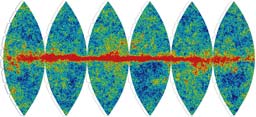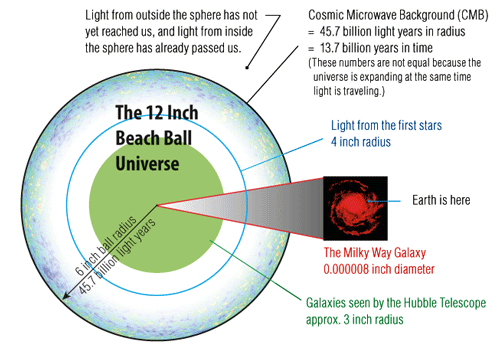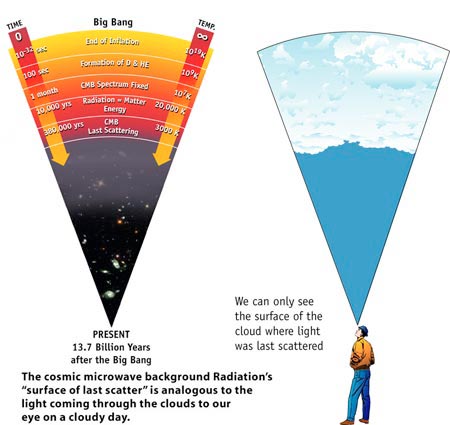
The Inflatable Universe
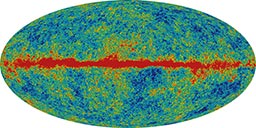
Full microwave sky view in a Mollweide projection |
|---|
A 12 inch inflatable globe (beach ball) can be used as a model of the observable universe. The ball's surface represents the furthest we can see in microwave light, the oldest visible light in the universe. The ball presents the baby picture created just 378,000 years after the Big Bang, ~13.8 billion years ago, before planets, stars or galaxies existed! The patterns imply a universe dominated by a mysterious "dark energy" and an exotic "dark matter." This full sky image of microwave light was captured by the Wilkinson Microwave Anisotropy Probe (WMAP). The WMAP team created a special inflatable beach ball with a representation of the microwave light pattern on it to help the public understand where this light comes from. This project is now 10 years old and the ball supply is exhausted, unfortunately. In place of the now defunct beach ball, here is a paper ball that can be cut out and assembled:
Hot and Cold Spots
The colors indicate temperature variations of light within the young universe, red for hotter, blue for cooler. These slight variations of temperature were caused by slight variations in the density of the matter from which the light was last scattered. But the red stripe along the globe's equator is a much more recent/closer/stronger foreground microwave signal from our Milky Way Galaxy.
The sizes of the hot and cold spots let scientists calculate fundamental values for the shape, size, age, rate of expansion (and more) of our universe.
| If the microwave light were shifted up to the visible spectrum and amplified, our eye would see a colorful rainbow of spots across the whole sky. | 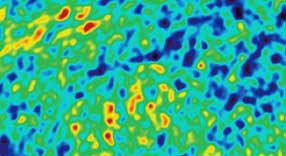 |
2.7251 kelvins 2.7249 kelvins |
12-inch Model of the Universe
The 12 inch ball (with a 6 inch radius) can represent the distance light has been able to travel in the nearly 13.7 billion years since the matter of the universe cooled to less than 3000 kelvins. We are at the center of this bubble of light, but many more times this volume of space exists outside this bubble, we just can not yet see its light. Every year the bubble of the observable universe grows a little larger as new light reaches our eyes. The bubble expands as the fabric of space itself stretches. Light stretches and cools (akin to distributing the same amount of energy within a continually expanding oven) toward the ultimate chilly "absolute zero" temperature (0 kelvins).
The light from the first stars appeared roughly 400 million years after the Big Bang. Yet in the model above it is a much larger distance in from the edge of the ball (about 10 billion light years). This is the result of the expanding fabric of space. The universe was more compressed, but expanding more rapidly than it is today.
What WMAP Sees
The temperature difference measured now between the coldest and hottest spots is extremely small, but the early universe was very hot. When the average density of matter in the universe was comparable to air at sea level, its temperature was 2.73 billion degrees! (The average density today is the equivalent of about one proton per cubic meter.) At these temperatures, protons and electrons could not bind together to form neutral atoms. The free electrons scattered the cosmic background radiation much as water drops scatter visible light in clouds, so the early universe would appear as a dense fog. As the universe expanded, it cooled. 378,000 years after the Big Bang, it was cool enough for protons and electrons to combine into neutral hydrogen. Neutral hydrogen is transparent, so the cosmic background radiation has traveled freely through the universe since that time.
On a cloudy day, we can look through the air to see the surface of the clouds. Similarly, we can see through the universe out to where it was filled with free electrons and see the “dense fog” that filled the early universe. The reason we can “see” the early universe is that we see objects as they were in the past due to the time it takes light to travel across space. For example, we see the Sun as it existed 8 minutes earlier. We see the “cloud surface” from which the cosmic background radiation was last scattered as it existed 13.7 billion years ago.
You can find out more about the WMAP mission and the solutions to some of the mysteries of our cosmos, starting on the WMAP Home page.
Notes: The presentation of the image on the beach ball above has been set to be viewed in the same fashion as an inflatable constellation guide. Hold it up to the sky and you can match the patterns on the ball to the patterns on the sky. So technically the image is inverted if you were positioned outside the bubble of light we can see. But this is of no importance in the scientific analysis of the image.

